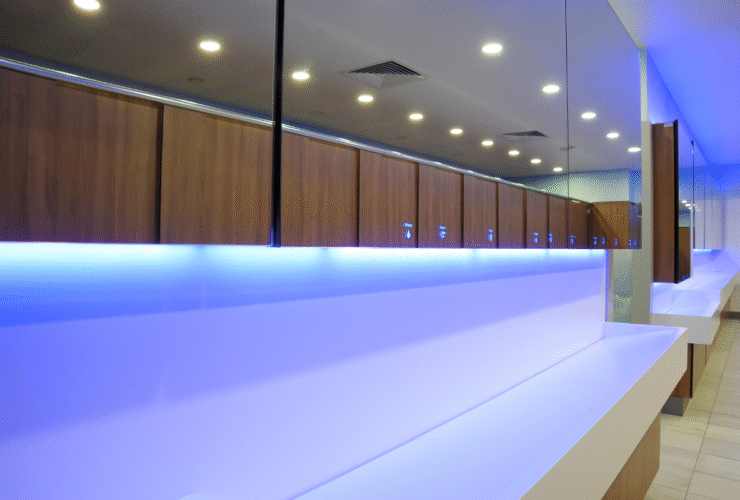While keeping washrooms clean and sanitary can prove a major challenge, there is a financial incentive for you to do so. According to recent reports, poor hygiene in the workplace alone is costing the UK economy £13.7 billion – equivalent to £700 per employee – in sick leave and lost work days each year.
Personal responsibility for washing hands correctly plays a major role but what about the washrooms themselves? How can they affect the hygiene of the people within your school or business? We believe the design of a washroom is more than just aesthetics. Our designers understand the importance of the following five factors and how they can overcome common hygiene challenges:
1. Floors
There are several ways to ensure floors remain easy to clean. The use of wall-hung toilets, for example, allows cleaners to mop underneath the toilet. When combined with additional design features such as seamless resin flooring we can further reduce the number of places where germs and dirt can collect.
2. Walls and doors
The sleek design of many of our washrooms ensure common areas of dirt collection such as walls and doors are as easy as possible to both use and clean. Hygiene-conscious designs should look to utilise larger wall tiles and Solid Grade Laminate Velocity Cubicles for example, which leave less grout exposed to gather germs. You can also improve hygiene by ensuring your doors are easier to open. Swing doors, for example, remove the need for handles – a hot spot for the transfer of dirt and grime – and are also easier to sanitise.
3. Air circulation
Washrooms are often warm and damp with little or no ventilation – providing the perfect breeding ground for germs. Extraction systems built in to the design of your commercial washroom improve air circulation and remove warmth and humidity, helping tackle the spread of nasty bugs.
4. Hand washing facilities
When it comes to personal responsibility for hygiene, hand washing is a major factor. Therefore, the accessibility and designs of hand washing facilities are paramount for boosting hygiene. Sensor taps not only help to alleviate water wastage but also provide fewer surfaces for hands and bugs to come into contact. Similarly, sensor-based soap dispensers can also help to reduce the spreading of germs. When it comes to drying hands, sensor-activated hand dryers eliminate direct contact and provide an environmentally-friendly solution. Paper towels also provide another hygienic option to consider. There are arguments for and against both options but the key thing to remember is to ensure both are kept well sanitised by your cleaning teams.
5. High-performance building materials
Quality products are essential when re-designing your washroom. Materials which are resilient to knocks and vandalism, as well as being impervious to water and damp, are important in keeping your washroom facilities looking clean, inviting and performing to the highest hygiene levels. High pressure laminate products, non-touch systems and solid surface materials all contribute to both the design but more importantly the hygiene of your washrooms.
Commercial washrooms are essential in the fight against the spread of disease, especially in shared environments such as schools and shopping centres. The implication of poorly designed facilities can have a wider reaching impact than simply looking unattractive. Investing in a well-designed washroom upgrade will help to improve the hygiene of your own building and reduce the spread of nasty diseases.
To find out more about commercial washroom design please contact us here.



